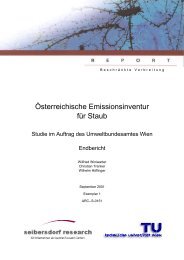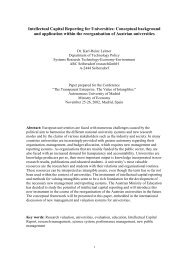ALPMON FINAL REPORT - ARC systems research
ALPMON FINAL REPORT - ARC systems research
ALPMON FINAL REPORT - ARC systems research
You also want an ePaper? Increase the reach of your titles
YUMPU automatically turns print PDFs into web optimized ePapers that Google loves.
Contract ENV4-CT96-0359 <strong>ALPMON</strong><br />
2.3.5 National Park Management, Swiss National Park, Engadine (WSL)<br />
2.3.5.1 Introduction and Objectives<br />
The Swiss National Park (SNP), first established in 1914, is the largest protected area and the only<br />
national park of Switzerland. It is located in the high-alpine region of the Engadine and covers an area<br />
of nearly 170 km2 . According to the International Union for the Conservation of Nature (IUCN), the SNP<br />
is classified as a "wilderness area" (category 1). It is especially known for its abundance of alpine<br />
fauna, such as red deer, ibex, chamois, groundhogs, and bearded vultures. Also, its characteristic<br />
landscape forms and rich alpine flora make it a tourist attraction of approximately 150'000 people a<br />
year.<br />
Besides the ecological and touristic aspects, the SNP serves as a field laboratory for diverse nature<br />
scientists. The park enables <strong>research</strong> to be pursued unhindered over a prolonged period of time in an<br />
area, that previously had been influenced by man. A huge amount of scientific <strong>research</strong> has been<br />
achieved over the last 80 years, adding to a lot of documentation of this area. A number of long-term<br />
monitoring programs have been set up, especially in the field of vegetation monitoring: development of<br />
vascular plants has been studied since 1917 (Braun-Blanquet 1931, Stüssi 1970, Krüsi et al. 1995,<br />
Schütz et al. 1998), the growth and succession of lichen since 1923 (Frey 1959), vegetation<br />
development in lavinars since 1939 (Lüdi 1954, Riederer 1996) and in fenced areas without the<br />
influence of mountain ungulates since 1987 (Camenish and Schütz in prep.), development of moss<br />
communities since the 50ties (Geissler 1993), reforestation on burnt areas since 1951 (Hartmann und<br />
Geissler in prep.), etc. In non-vegetation areas, studies of geomorphological forms such as rock<br />
glaciers (Barsch 1996, Graf et al. 1995) and processes (solifluction) have been under study.<br />
In summary, a lot of detailed spot data has been collected for different areas in the park, but no areawide<br />
data coverage is available for any specific characteristic, since <strong>research</strong>ers are allowed to leave<br />
paths only in specified areas for which they have a permit. Thus, there is a lack of actual and proved<br />
information concerning the spatial pattern of various objects and processes for the entire park. For this<br />
purpose, the feasibility of remote sensing techniques has been tested. There is a need to obtain a<br />
complete inventory, especially of the most inaccessible and remote corners of the park. Also in respect<br />
to the planned park extension, information on the use and type of landscape outside of the park<br />
boundaries is of vital interest.<br />
The Swiss National Park is in need of a spatially comprehensive inventory of grassland, forest stand<br />
characteristics (tree species composition, stand type, stand density, natural age class) and nonvegetation<br />
areas. In the latter respect, the extension and spatial distribution of soil erosion, especially<br />
of debris flows, rockslides, lavinars and active rock glaciers greatly influence the vegetation succession<br />
and the accessibility of the park in general. This basic data is needed for various applications, which<br />
can be used as a planning instrument for national park management.<br />
2.3.5.2 User Requirements<br />
Table 8 lists the applications of interest and the types of data required by the SNP management (WP1<br />
Customer Requirements).<br />
JR, RSDE, ALU, LMU, Seibersdorf, WSL 53




